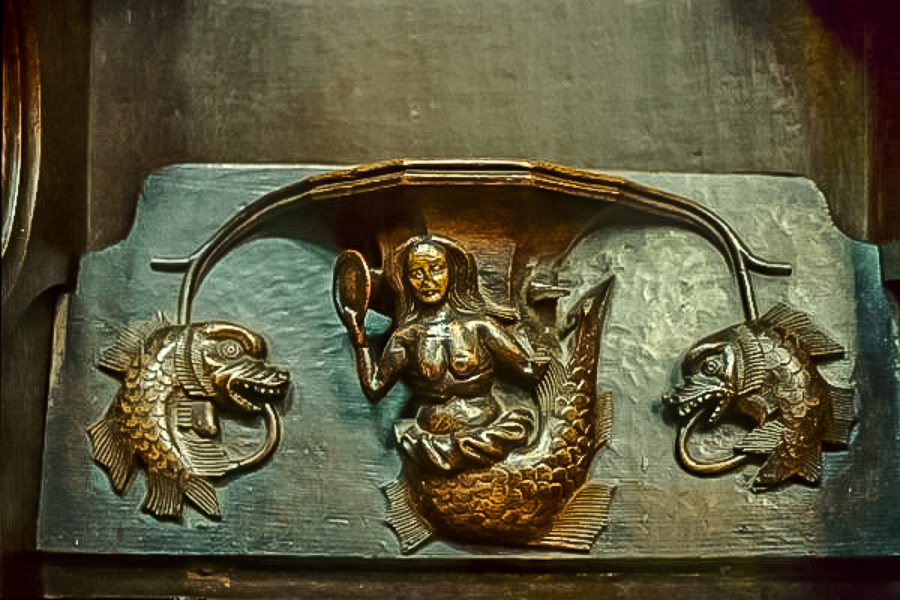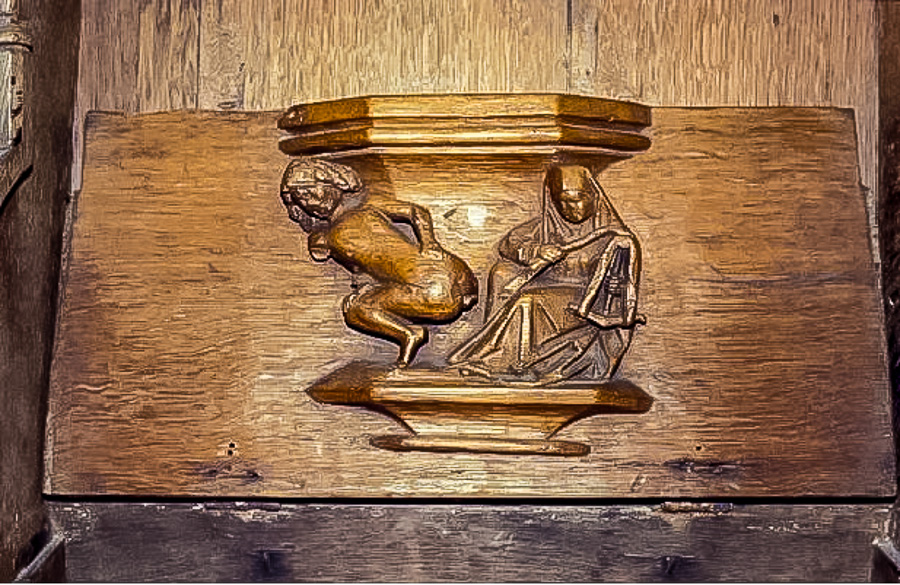The History and Mysteries of Europe’s Misericords Part III by Dave Douglas Davis
If you’re in luck and look closely, maybe next time you’re in a church, you can spot a so-called Misericord, or Mercy Seat, under the seats of the folding choir chairs. They were used by the monks throughout the Middle Ages as a standing aid during the long hours of praying.
In many ways the Misericords represent the expansion of the longstanding (no pun intended) tradition of decorative ecclesiastical stonework into a different medium. Wood was easier to manipulate than stone, and lent itself to more iconographic complexity and a wider range of subjects.
Continuing the oral tradition – in wood
Misericords became playgrounds for the Medieval artisan’s imagination, and they represented a fascinating array of subjects. To be sure, many of them convey sacred themes. For example, every one of the 110 misericords in the Cathédrale Notre-Dame in Amiens, France focuses on a biblical topic. Created, as they were, in a world where few people were literate and the great traditions of one’s culture were passed along orally, these carvings refer to stories that would have been familiar to the average person. There is Moses receiving the commandments; David slaying Goliath; Moses in the bulrushes; and so on.
- Pharaoh’s soldiers drowning Hebrew infants. Cathédrale Notre-Dame d’Amiens, Amiens, France. Courtesy of https://misericords.co.uk
- The Green Man, an important element of pre-Christian mythology throughout Europe, appears fairly often as a misericord carving. La Trinité, Vendôme, France. Courtesy Elaine C. Block collection
But by no means do all misericords deal with Biblical references or sacred themes. Sometimes there is a mix of sacred and secular subjects. For example, at Bristol Cathedral in the UK, Adam and Eve share the choir stalls with Samson, but also with a woman throwing a bowl at a man as he lifts the lid of her cooking pot.
The imagination of the Medieval Mind
Misericords at Magdeburg Cathedral in Germany include depictions of angels, devils, and clerics along with various wild and domestic animals, a dancing woman, and a knight battling a lion. The more widely we look, the more diverse the subjects become. And so one naturally asks, just what is going on here? The topics that were chosen by the craftsmen who carved these images could not simply have been random products of each individual’s particular mindset. Or could they?
The answer is yes and no. At the end of the day, there are some misericords that simply defy explanation, which is to say that we have no idea why the craftsman chose that particular subject. Examples are not hard to come by. For example, the wyvern or two-legged dragon, a common element in Medieval heraldry, sometimes appears as the sole image in a misericord carving. Equally common are misericords depicting the Green Man, a supposedly pagan image that has no obvious place in a Catholic church. Do images like these reflect some once-popular but now obscure proverb or tale? Or are they simply topics or scenarios that happened to capture the imaginations of certain woodcarvers?
- Men drinking. St. Nicholas Church, Amsterdam, Netherlands
- Woman pouring ale, Church of Notre Dame, Breda, Netherlands
Fiction, fables and foxes
On the other hand, some misericords find a ready home in the popular folklore of the time. These include numerous carvings that represent scenes from stories about Reynard the Fox. The Reynard tales seem to have originated in Alsace-Lorraine in the twelfth century, but during the next couple of hundred years they became enormously popular throughout Europe. The stories related the exploits of peasant-hero Reynard, a fox whose adventures frequently highlighted the hypocrisy and pretensions of the aristocracy. By the fourteenth century, the stories were appearing in numerous poetry and prose versions, and in languages that included Latin, German, Dutch, French, and ultimately English. Indeed, Reynard even appears in Chaucer’s Canterbury Tales, as the character Rossel in the Nun’s Priest’s Tale.
The world of Reynard is populated by an array of anthropomorphised animals, each of them representing particular human proclivities, vices, and virtues. The wolf, the bear, the cat, and a host of others can often be recognized in misericords by their contexts as characters from Reynard stories. An excellent example is provided by a sixteenth century misericord from Bristol Cathedral, in which Tybalt the Prince of Cats, who has been sent to capture Reynard, is caught up in a misadventure involving the priest and his mistress while the fox looks on and makes ready his escape.
Characters from Aesop’s fables also make appearances in misericord carvings. The fables had been retold for centuries, and by Medieval times some Aesop characters had become subjects of other European folk tales. For example, the ape (from the Aesop story “The Ape and the Fox”) appeared in other stories as a symbol for a variety of human failings, occasionally even serving as a stand-in for the Devil.
Medieval bestiary
Another rich source of subject matter for misericords was the Medieval bestiary, which had their origins in texts of the ancient world about creatures ranging from apes to pelicans, and from mermaids to the phoenix. The mermaid or siren, for example, is widely depicted in misericords, usually holding a mirror and a comb to connote vanity. Swans, who are said to sing most sweetly on the night before they die, connoted romantic love. They also were sometimes claimed as ancestors of the nobility. The stag, a noble creature, is the eternal enemy of the snake and often stands as a symbol of Christ. To the Medieval mind, the frontier between real and imaginary was shadowy and fluid.
The mere fact that a beast like the phoenix was not part of an average person’s experience did not necessarily mean that it was a fiction, but only that it existed in some far away land, or in some distant past. It was therefore just as plausible for a misericord to feature a muscaliet (a creature with the teeth of a boar, the tail of a squirrel, and the body of a hare) as it was to portray a fox or a crane. To the Medieval way of thinking, every creature in the bestiary had something to tell us about the Creator’s plan, which was more than enough reason for depicting them in a church.
The naughty ones
However, there is another category of misericords that can’t be so readily explained in an ecclesiastical setting. There is a rather large group of images that range from mere curiosities to mildly humorous to downright lewd.
On the merely curious end of the spectrum are drinking scenes, which are common subjects of misericords. From these, we move on to the mildly humorous, such as the misericord in Chichester Cathedral, UK, of a musician stealing a kiss from a female dancer, or the image in Bolsward Church, St.-Martin, Netherlands of a man dancing with a pig.
And somewhere closer to the bawdy end of the range, we encounter carvings like the depiction of a woman gathering excrement from a nude man at Oude Kerk (St. Nicholas) in Amsterdam, or the image in the Church of Notre Dame in Rodez, France of a man parting his buttocks to expose his rectum as he looks between his legs at the viewer.
So next time you’re in a church, check out the hidden Misericords under the seats of the choir. Maybe you’ll find a more entertaining story than you thought.
If you want to discover the monks’ side of the Misericord story, read the first part of Hidden Beneath the Seats – Père Dominique’s tale. In the second part of Hidden Beneath the Seats – The History of the Misericords you can find out more about the origins and extent of the Mercy Seats in Europe.
Learn more






